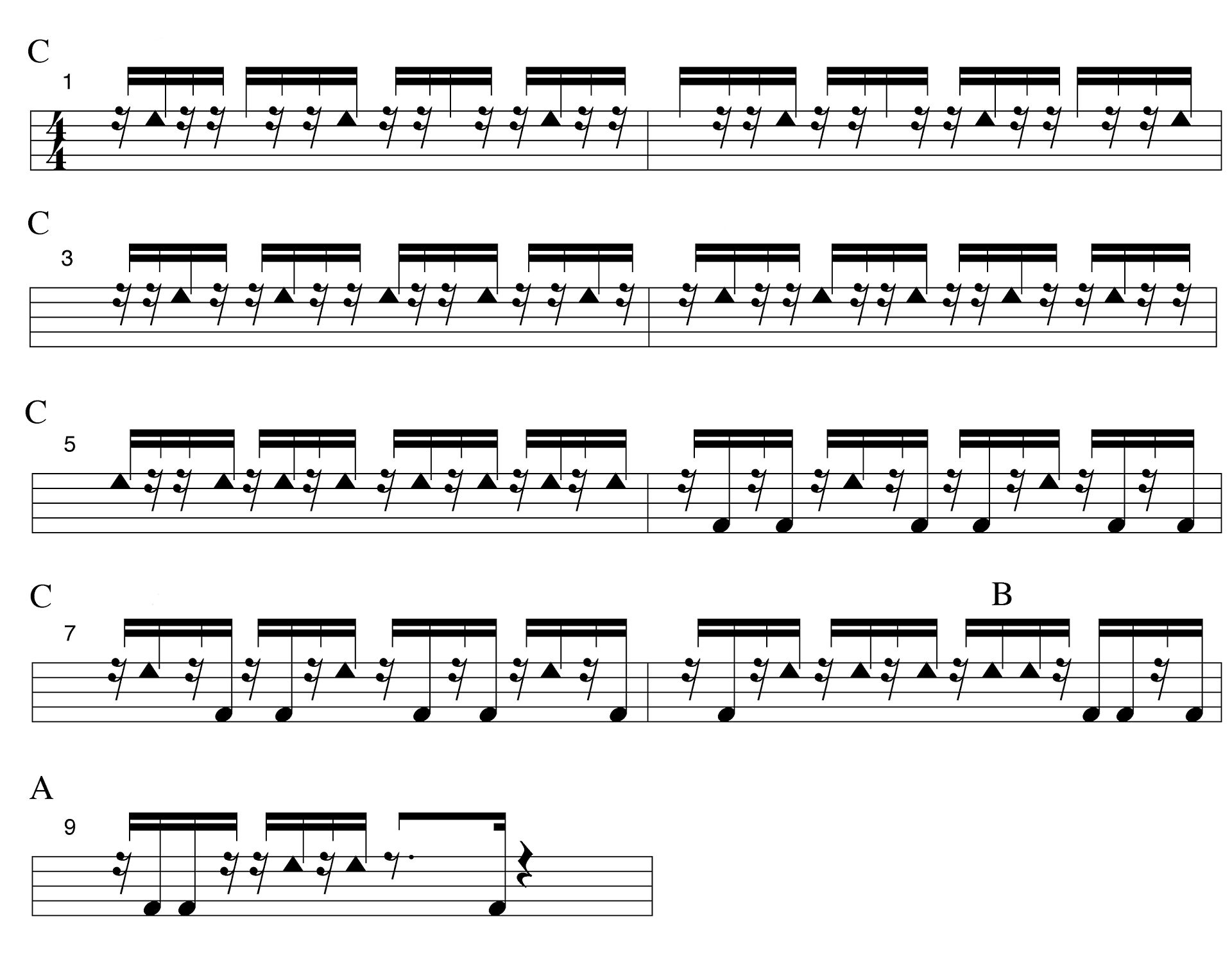
グアグアンコー
Guaguancó
Matanzas-style
guaguancó guagua pattern
☆ グアグアンコー(スペイン語発音:[ɡwaɣwaŃko])は、キューバン・ルンバ(Cuban rumba)のサブジャン ルで、パーカッション、声、ダンスを組み合わせたものである。主に2つのスタイルがある:つまり ハバナとマタンサスがある。
| Guaguancó
(Spanish pronunciation: [ɡwaɣwaŋˈko]) is a subgenre of Cuban rumba,
combining percussion, voices, and dance. There are two main styles:
Havana and Matanzas. |
グアグアンコー(スペイン語発音:[ɡwaɣwaŃko])は、キュー
バン・ルンバのサブジャンルで、パーカッション、声、ダンスを組み合わせたものである。主に2つのスタイルがある: ハバナとマタンサスである。 |
| Percussion battery of three conga drummers: the tumba (lowest), tres dos (middle, playing a counter-clave), and quinto (highest, and lead drum). These parts may also be played on cajones, wooden boxes. claves usually played by a singer guagua (aka Catà) (hollowed piece of bamboo) maraca and/or a chekeré playing the main beats Other instruments may be used on occasion, for example spoons, palitos (wooden sticks striking the side of the drum), and tables and walls played like drums. Clave Rumba clave in duple-pulse and triple-pulse structures Rumba clave is the key pattern (guide pattern) used in guaguancó. There is some debate as to how the 4/4 rumba clave should be notated for guaguancó.[1] In actual practice, the third and fourth stroke often fall in rhythmic positions that do not fit neatly into music notation.[2] Triple-pulse strokes can be substituted for duple-pulse strokes. Also, the clave strokes are sometimes displaced in such a way that they don't fall within either a triple-pulse or duple-pulse "grid".[3] Therefore, many variations are possible. Guagua The guagua pattern (also known as palitos, or cáscara) contains all of the strokes of clave.  Matanzas-style guaguancó guagua pattern Quinto  All modes of quinto in context. Quinto excerpt from "La polémica" by Los Muñequitos de Matanzas (1988). The following nine-measure excerpt is from the guaguancó “La polémica" by Los Muñequitos de Matanzas (1988).[4] This passage moves between the main modes of playing (A,B,C). The A section is the basic lock or ride, as it is known in North America. It spans one clave (measure). An alternate phrase (B) is also one measure in length. Cross-beats, the basis of the third section (C), contradict the meter. By alternating between the lock and the cross, the quinto creates larger rhythmic phrases that expand and contract over several clave cycles. The great Los Muñequintos quintero Jesús Alfonso (1949–2009) described this phenomenon as a man getting "drunk at a party, going outside for a while, and then coming back inside."[5] |
パーカッション トゥンバ(最下部)、トレス・ドス(中間部、カウンター・クラーベを演奏)、キント(最高部、リード・ドラム)の3人のコンガ・ドラム奏者で構成される。 これらのパートはカホン(木製の箱)で演奏されることもある。 クラベは通常歌手が演奏する。 グアグア(別名カタ)(竹をくり抜いたもの) マラカおよび/またはチェケレが主要なビートを演奏する。 スプーン、パリトス(太鼓の側面を叩く木の棒)、太鼓のように叩くテーブルや壁など、他の楽器が使われることもある。 クラーベ  ルンバ・クラーベの二重拍子と三重拍子 ルンバ・クラーベは、グアガンコーで使われるキー・パターン(ガイド・パターン)である。4分の4拍子のルンバ・クラーベをグアガンコーでどのように表記 するかについては議論がある[1]。実際の練習では、第3ストロークと第4ストロークはしばしばリズムの位置にあり、楽譜にきれいに収まらない[2]。ま た、クラーベのストロークは、3連パルスと2連パルスのどちらの「グリッド」にも入らないようにずらされることもある[3]。したがって、多くのバリエー ションが可能である。 グアグア グアグアのパターン(パリトス、またはカスカラとも呼ばれる)には、クラーベのすべてのストロークが含まれる。  マタンサス式グアグア・パターン キント  キントの全モードが文脈に含まれる。Los Muñequitos de Matanzas (1988)の 「La polémica 」からの抜粋。 次の9小節の抜粋は、ロス・ムニェキトス・デ・マタンサス(Los Muñequitos de Matanzas)のguaguancó 「La polémica」(1988)からのものである[4]。このパッセージは、演奏の主要なモード(A,B,C)の間を移動する。Aセクションは、北米で知 られているように、基本的なロックまたはライドである。1クラーベ(小節)にまたがる。別のフレーズ(B)も1小節の長さである。第3セクション(C)の 基本であるクロスビートは、メーターに反する。ロックとクロスを交互に繰り返すことで、キントは大きなリズムのフレーズを作り出し、いくつかのクラーベの サイクルにわたって伸縮する。ロス・ムニエキントスの偉大なキンテーロ、ヘスス・アルフォンソ(1949~2009)は、この現象を「パーティーで酔っ 払って、しばらく外に出て、また中に戻ってくる」男のようだと表現した[5]。 |
| Song The term guaguancó originally referred to a narrative song style (coros de guaguancó) which emerged from the coros de claves of the late nineteenth and early twentieth centuries. Rogelio Martínez Furé states: "[The] old folks contend that strictly speaking, the guaguancó is the narrative."[6] The guaguancó song often begins with the soloist singing meaningless syllables, which is called the diana. According to Larry Crook, the diana is important because it "... also contains the first choral refrain. The lead singer provides a phrase or motive for the choral sections, or they may present new, but related material. Parallel harmonies are usually built above or below a melodic line, with thirds, sixths, and octaves most common."[7] Therefore, the singer who is presented with singing the diana initiates the beginning of the guaguancó. He then may proceed to improvise lyrics stating the reason for holding the present rumba ('decimar'; span.: to make ten-line stanzas), During the verses of the song the quinto is capable of sublime creativity, while musically subordinate to the lead vocalist. There are natural pauses in the cadence of the verses, typically one or two measures in length, where the quinto can play succinct phrases in the "holes" left by the singer. Once the chorus (or montuno section) of the song begins, the phrases of the quinto interact with the dancers more than the lead singer. |
歌 グアグアンコーという言葉はもともと、19世紀末から20世紀初頭にかけてのクラベのコロス(coros de claves)から生まれた物語性のある歌のスタイル(coros de guaguancó)を指していた。ロジェリオ・マルティネス・フーレはこう述べている: 「グアグアンコの歌は、しばしばソリストが意味のない音節を歌うことから始まるが、これはディアナと呼ばれる。ラリー・クルックによれば、ディアナが重要 なのは、「...最初の合唱のリフレインも含まれている」からである。リード・シンガーは、合唱セクションにフレーズや動機を提供したり、新しい、しかし 関連性のある素材を提示したりする。平行和声は通常、旋律線の上または下に構築され、3分の3、6分の6、オクターブが最も一般的である。歌の詩の間、キ ントは、音楽的にはリード・ヴォーカリストに従属しながらも、崇高な創造性を発揮することができる。詩のカデンツには自然な間があり、通常1、2小節の長 さだが、そこでキントは歌手の残した「穴」に簡潔なフレーズを奏でることができる。曲のサビ(またはモントゥーノ・セクション)が始まると、キントのフ レーズはリード・シンガー以上にダンサーと相互作用する。 |
| Dance Guaguancó is an Afro Cuban couple dance of sexual competition between the male and female. The male periodically attempts to "catch" his partner with a single thrust of his pelvis. This erotic movement is called the vacunao (‘vaccination’ or more specifically ‘injection’), a gesture derived from yuka and makuta [dances], symbolizing sexual penetration. The vacunao can also be expressed with a sudden gesture made by the hand or foot. The quinto often accents the vacunao, usually as the resolution to a phrase spanning more than one cycle of clave. Holding onto the ends of her skirt while seductively moving her upper and lower body in contrary motion, the female "opens" and "closes" her skirt in rhythmic cadence with the music. The male attempts to distract the female with fancy (often counter-metric) steps, accented by the quinto, until he is in position to "inject" her. The female reacts by quickly turning away, bringing the ends of her skirts together, or covering her groin area with her hand (botao), symbolically blocking the "injection." Most of the time the male dancer does not succeed in "catching" his partner. The dance is performed with good-natured humor—David Peñalosa.[8] Vernon Boggs states that the woman's "dancing expertise resides in her ability to entice the male while skillfully avoiding being touched by his vacunao."[9] The pattern of quinto strokes and the pattern of the man's dance steps are at times identical, and at other times, imaginatively matched. The quinto player must be able to switch phrases immediately in response to the dancer’s ever-changing steps. |
ダンス グアグアンコーはアフロ・キューバン・カップル・ダンスで、男女の性的な競争である。男性は定期的に骨盤を一突きしてパートナーを「捕まえ」ようとする。 このエロティックな動きはヴァクナオ(「ワクチン接種」、より具体的には「注射」)と呼ばれ、ユカやマクタ[ダンス]に由来するジェスチャーで、性的な挿 入を象徴している。ヴァクナオは、手や足の突然のジェスチャーで表現することもできる。クイントはしばしばヴァクナオにアクセントをつけ、通常はクラーベ の1サイクル以上にまたがるフレーズの解決として使われる。スカートの端を掴みながら、上半身と下半身を相反する動きで魅惑的に動かし、女性は音楽に合わ せてリズミカルにスカートを「開いたり」「閉じたり」する。男性は、キントでアクセントをつけながら、派手な(しばしば反計量的な)ステップで女性の気を そらし、「注入」できる位置まで持っていこうとする。女性は素早く背を向け、スカートの端を合わせ、あるいは手で股間を覆い(ボタオ)、象徴的に 「注射 」を阻止する。ほとんどの場合、男性ダンサーはパートナーを「捕まえる」ことに成功しない。このダンスはユーモアを交えて踊られる。 バーノン・ボッグスは、女性の「踊りの専門知識は、男性のヴァクナオに触られるのを巧みに避けながら、男性を誘惑する能力にある」と述べている[9]。キ ント奏者は、ダンサーの刻々と変化するステップに応じて、即座にフレーズを切り替えることができなければならない。 |
| Selected discography Songs and Dances (Conjunto Clave y Guaguancó) Xenophile CD 4023 (1990). Déjala en la puntica (Conjunto Clave y Guaguancó) Egrem CD0211 (1996). Rapsodia rumbera (El Goyo) Egrem CD 0121 (1995). Aniversario (Tata Güines) Egrem CD 0156 (1996). Guaguancó, v. 1 (Los Muñequitos [Grupo Guaguancó Matancero], Papin) Antilla CD 565 (1956, 1958). Guaguancó, v. 2 (Los Muñequitos [Grupo Guaguancó Matancero], Papin) Antilla CD 595 (1958). Rumba caliente (Los Muñequitos) Qbadisc CD 9005 (1977, 1988). Vacunao (Los Muñequitos) Qbadisc CD 9017 (1995). Ito iban echu (Los Muñequitos) Qbadisc CD 9022 (1996). Rumberos de corazón (Los Muñequitos) Pimienta CD 566-2 (2003). Tambor de fuego (Los Muñequitos) BIS CD 296 (2007). D’palo pa rumba (Los Muñequitos) BIS CD 745 (2009). Oye men listen . . . guaguancó (Los Papines) Bravo CD 105 [n.d.]. Homenaje a mis colegas (Los Papines) Vitral CD 4105 (1989). Tambores cubanos (Los Papines) Bárbaro CD 239 (1995). Papines en descarga (Los Papines) Orfeón CD 16181 (2001). Siguen OK (Los Papines) Egrem CD (2004). El tambor de Cuba (Chano Pozo) Tumbao CD box set 305 (1947). Drums and Chants [Changó] (Mongo Santamaría) Vaya CD 56 (1954). Afro Roots [Yambú, Mongo] (Mongo Santamaría) Prestige CD 24018-2 (1958, 1959 ). Festival in Havana (Ignacio Piñeiro) Milestone CD 9337-2 (1955). Patato y Totico (Patato Valdés) Verve CD 5037 (1968). Authority (Patato Valdés) LPV CD 103 (1976). Ready for Freddy (Patato Valdés) LPV CD 104 (1976). Ritmo afro-cubano (Carlos Vidal Bolado) sides 7, 8 SMC 2520 78 rpm phonorecord (ca. 1949). El callejón de los rumberos (Yoruba Andabo) PM CD DM203 (1993). Guaguancó afro-cubano (Alberto Zayas) Panart 2055 (1955, 1956). |
|
| https://en.wikipedia.org/wiki/Guaguanc%C3%B3 |
|
リ ンク
文 献
そ の他の情報
Copyleft, CC, Mitzub'ixi Quq Chi'j, 1996-2099
☆
 ☆
☆